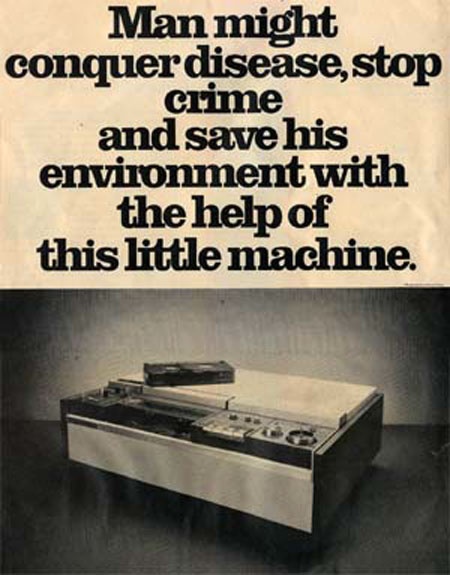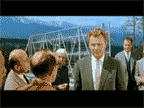
WILL VAMPLING REPLACE CINEMA AS WE KNOW IT ?
Cine-itinerants
While there are many vamplers performing in various contexts such as nightclubs and museums, we envisage a time when these performers will be touring and creating live cinema all around the world. Perhaps these vamplers will may even take over where the experience of mass-distributed cinema ends. Travelling performers will roll into town reminiscent of the cine-itinerants Dwayne Esper (USA), or Alexander Medvedkin (Soviet Union). Imagine the marquis being changed nearly daily. One would no longer say "I'm going to see such and such a film", but "I'm going to see so and so vample (or perform a movie)". In effect, vampling resides somewhere between the cinema experience and a concert, yet it is neither one or the other which makes its introduction into a culture an uphill battle for a variety of reasons.
Call and Response
Where the typical cinema experience involves almost no audience participation, a vampling "show" is created on the fly. Vamplers can respond to different geographic, cultural, and socio-economic contexts as well as audience natures by altering different variables: more/less abstract, less/more narrative elements, louder, softer, slower/faster, longer/shorter, smoother, darker/brighter, sharper/blurrier, more/less colorful, comedic, dramatic, sublime! The possibilities and mutations of as well as it's physiological effects are unfathomable.
Some vamplers are asking "Does the world need more products, anchored to rot in time?". This fan of vampling says "NO!". The live experience is still the open frontier. It reintegrates the collective experience whereby the call comes during the performing and the malleable array of space, time, and affect is the response.
VAMPLES
Within each of the audio-visual samples (vamples), be they shot of found, comes the experience integrated in that shot/fragment. Even the most abstract image documents a time, place, and unique perspective. At the very most, we can speak of the hundreds of participants involved in the creating of a shot from a Hollywood film whose experiences, although highly "refined" may have affect given recorded moment. At the very least we can speak of the perspective of camera eye, or some living presence acting at some point in the creation of a home-movie image. So in terms of perspective, all films are documentaries as much as they are fictions and vampling is as such an assemblage of "facts" and "perspectives" coming from an infinite pool of cultural production.
Vampling Ripples
The average American watches 4.5 hours of television a day (see Nielsen Survey). What happens when such a population is intaking the same television programs, the same movies with the same linear structures? We know from a variety of studies that perspectives on a variety of subjects become uniform. Of course, what we have come to know as traditional film creation or viewing have important roles in society. Nevertheless, the clear homogenizing of North American culture or any other television imbued culture has reached dangerous levels. Vampling can bring an increasingly separated people together and not as passive recipients, but as participants in this unique (everytime) and seductive experience which takes charge of a familiar syntax but involves a very direct human controlled "delivery system".
Constructivist poet and filmmaker Vladimir Mayakovsky, whose approach to creation much inspired Dziga Vertov, called upon each artist to accumulate "warehouses of preliminaries" ready for any contingency. So can the vampler, amassing sound/image "vamples", respond to whatever the call may be.

Vladimir Mayakovsky, 1912

Sony advertisement for the U-Matic 3/4 in. video deck, Life Magazine (ca. 1974).
If only it were true, or does Sony know something they're not telling us?
VAMPLERS IN CONTEXT
Recent expositions at the Pompidou Center in Paris or the Hirshhorn Museum in Washington, DC have lightly touched on the increased interest in this domain of synaesthetic art. However, the expos have also exposed the typical problems of their respective curators, the incapacity to create a forward looking expo that makes deals not just with the dead but also with the living. There was even no mention of the pioneering work of Negativland or EBN! Out in the often lawless turbulent international waters,.vampling's pirate image seems to scare away the queasy.
For a few decades now, this sort of non-linear performing has taken root, yet since the 1920’s, filmmakers such as Dziga Vertov with his Trois Chants sur Lenine or Henri Storck have been recycling sound film. And since WWII, Bruce Conner, and his former student Craig Baldwin, Cecile Fontaine, Maurice Lemaître and many others have been setting forth their visions of opposing disparate space-time fragments drawn from the "material-naïa" (material culture). The live reassembling of moments can also be considered an audio-visual extension of musique concrète.. Pierre Schaeffer, the principal pioneer of musique-concrète, experimented with the creation of "pure" image/sound relationships in his rudimentary films of the 1950's though these were fixed on celluloid and not performed per-se.
In the seventies, members of groups such as the Video Freex Collective were already sampling and scratching video with the audio with the most rudimentary of tools such as "prepared" 1" and 3/4" decks.
Prior to that, the sixties film collective The Newsreel (now www.twn.org) also saw in the use of found footage a means of tapping into levels of image-consciousness as catalysts for political awareness. With an impressive network, the members shared archive footage on a global scale with liberation movements in Vietnam, Cuba (Santiago Alvarez), and Angola. In the USA, the films were largely accompanied by the members during screenings and while this was clearly not "vampling", the screenings were almost always "events" replete with eruptions and discussions. The occasions were palpably "live" and dynamic. Could vamplers take cues from The Newsreel's approach as we are faced with similar political crises?


